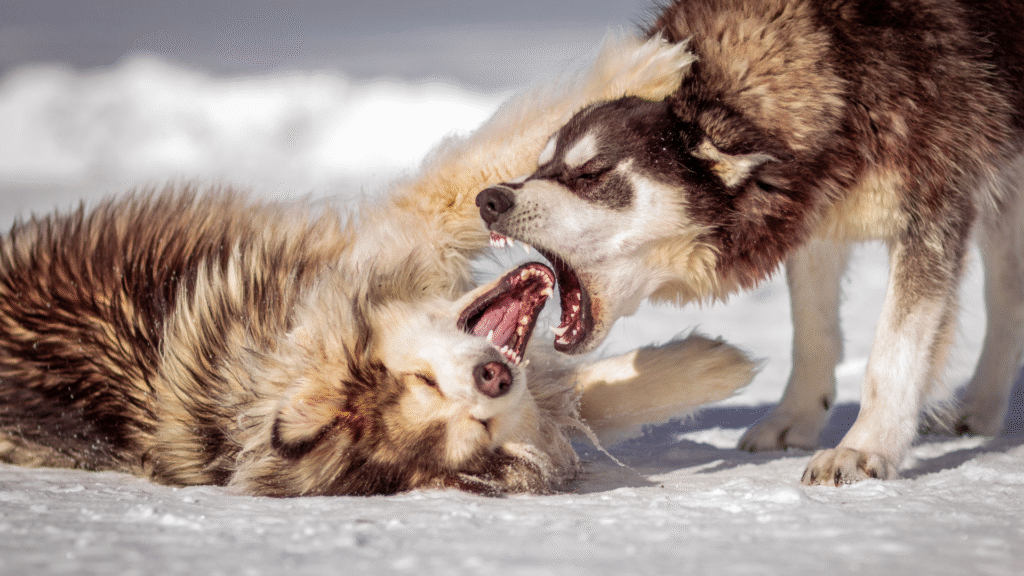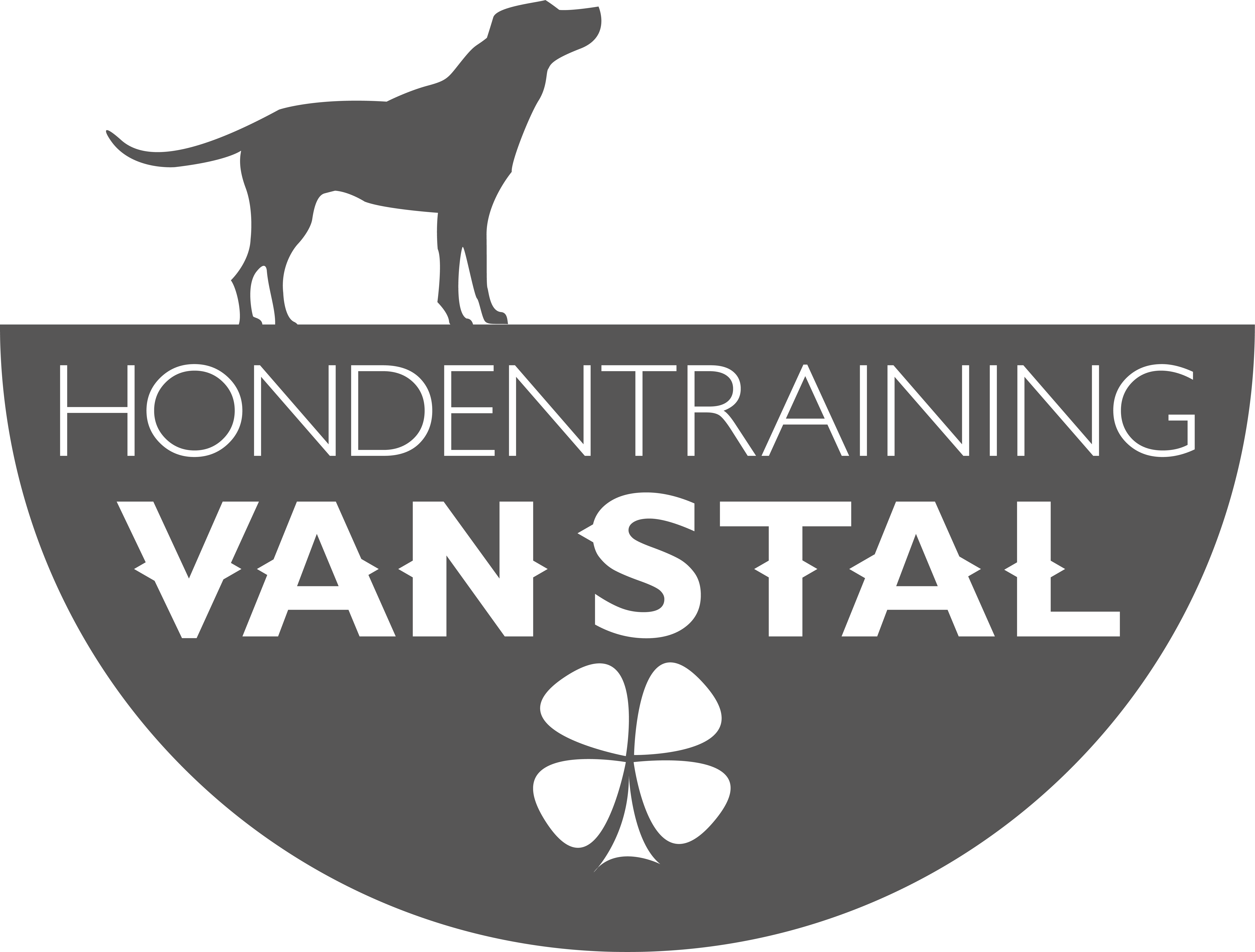Origin of dominance
Our modern domestic dog originated after a long process of domestication of the wolf. That is why a lot of research was done on wolves in order to explain the behaviour of dogs. Between 1934 and 1942, researchers led by Rudolph Schenkel studied groups of wolves and their relationships with each other. It was assumed that a pack in the wild was formed by individual wolves who needed each other in difficult times. Therefore, a group of random wolves in captivity was observed with the aim of recording their relationships and analysing how they came about. In this group, aggressive confrontations often occurred, with the strongest ultimately prevailing. This wolf was called the alpha wolf. Because dogs are descended from wolves, this dominance theory was extended to our domestic dogs.
Many scientists adopted this conclusion, thereby perpetuating the dominance theory. Even today, dogs are often still regarded as animals to which dominance techniques must be applied in order to prevent behavioural problems.

In most cases, dominance theory was cited as the solution, because behavioural problems were thought to be caused by the dog’s urge to climb higher on the social ladder. Disobeying commands, sitting higher (e.g. on the sofa), walking through the door first and eating before the owner were all seen as signs that the dog was trying to dominate humans. According to this theory, in order to restore obedience in domestic dogs, this behaviour had to be broken through punishment and subjugation of the dog (Kovary, 1999).
Wolf biologist Dr. L. David Mech came to similar conclusions in the 1970s and 1980s. Since even this prominent biologist made this claim, the theory was accepted as truth.
Criticism of dominance
Let’s take a closer look at the original study. It was conducted on a random group of wolves. Only later was more research done on wolf packs in the wild. This showed that wolves actually live in families. The father and mother lead the pack, and the pups leave the group when they are old enough.
During Schenkel and Mech’s research, the wolves were kept in a small space with little food. This logically led to conflicts, which had nothing to do with hierarchy, but were rather focused on obtaining food. Years later, the same wolf biologist, Dr. L. David Mech, concluded that the older animals were not trying to dominate the others, but rather to protect and care for the group. Conflicts were rarely resolved with aggression (Mech, 2008). Mech therefore revisited his earlier findings and concluded that the term “alpha wolf” was no longer applicable.
More and more studies confirmed that this earlier image of wolves did not correspond with their behaviour in the wild. Several researchers concluded that the initial studies were not representative.
Given that more and more studies show that there is no strict hierarchy in wolf packs (let alone aggressive behaviour), the argument that dogs exhibit this behaviour is refuted (Van Kerkhove, 2004).
And what about wild (street) dogs? After all, they are closer to our domestic dogs. Research shows that there are few conflicts that indicate a hierarchical structure. However, the group structure has changed compared to wolves, as street dogs no longer live in families. The behaviour of these dogs is explained more by circumstances, learning experiences and motivation. Most interactions are characterised by “calming signals”, which are intended to reduce conflict. These behaviours are therefore not aimed at submission to a more dominant dog, but are intended to de-escalate the situation.
The word “dominance” is also often used incorrectly. Dominance is a description of a mutual relationship (between two individuals), not a character or behavioural trait. This relationship can vary depending on the context and time. While one dog may appropriate a bone at a certain moment, this may not be the case at another moment.
Does dominance exist? Certainly, but it is not an end in itself. It is a description of the current relationship between dogs and/or humans. And these relationships can vary depending on the moment and context.
In short, multiple studies have shown that dogs do not need or want to obtain a dominant position or dominant leadership.

Behavior vs training
But what about behaviour that we would rather not see? For example, growling when the dog is lying on the sofa? Or pulling on the leash? Or lunging at the leash? Or bumping into your leg?
A 2009 study by Bradshaw examined a group of 19 dogs in a single household. It found that no fixed hierarchy could be established based on their interactions. However, there were conflicts, which were sometimes resolved by calming signals or aggression. This behaviour can be better explained by the concept of “Resource Holding Potential”: the motivation to obtain or retain something that has value for the dog. An example:
When a dog lies on the sofa, it can be a very comfortable place. If he wants to stay there, he may growl to keep his spot. But if he is less motivated, he will leave the spot without protest.
If the dog pulls on the leash, it is usually because it has a strong motivation to go somewhere. The reason may be obvious (another dog) or less obvious (e.g. wanting to get away from a frightening situation). But this has nothing to do with dominance or determining the route.
As discussed earlier, behaviour can mainly be explained by the emotions experienced by the dog (Panksepp, 2005). Dogs experience seven basic emotions: desire/searching, anger, fear, lust, care, panic and play/pleasure. These emotions, combined with learning experiences, form the behaviour we observe.
An example: a dog that growls at its food bowl. Body language indicates that this is often a sign of fear, fear that its food will be taken away. If it growls and you back away, it learns that growling works to reduce its fear. If the neighbour comes by and he doesn’t growl, it may be because she has never taken his food bowl away. So he has no negative experience with her that causes fear. This results in two different reactions in the same situation, previously interpreted as attempts at dominance, while the difference lies in previous experiences.
Within dominance theory, a physical approach is often chosen: an “alpha role”, a nudge in the side or pinning the dog down. If a dog misbehaves, lay him on his side to “subdue” him. Unfortunately, these actions appear effective at first glance.
This is why many ‘trainers’ see this as a quick way to correct undesirable behaviour. But the opposite is true. Many dogs stop the undesirable behaviour out of fear of the consequences, not because they have unlearned it. They develop a condition called ‘learned helplessness,’ which is considered a serious mental disorder. The dog may also become more fearful, which actually motivates it to defend its food bowl. This worsens the relationship with the owner. Wouldn’t we rather have a dog that trusts, respects, supports and shows affection towards us? Then we must also give this to the dog. Respect its behaviour, emotions and needs, and support it where necessary.
If we correct growling, there is a good chance that the dog will skip this signal and bite immediately. This makes him unpredictable and increases the risk of him ending up in a shelter.
By looking at the underlying emotion and motivation, other, non-physical techniques can be used to teach the dog different behaviour. This may take a little longer, but it strengthens the bond between dog and owner, and the desired behaviour lasts longer.

